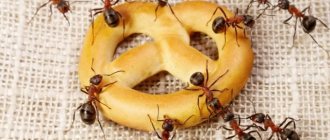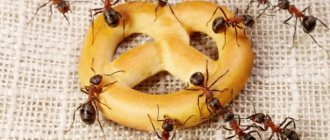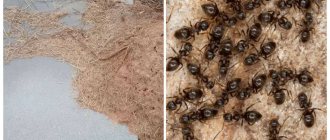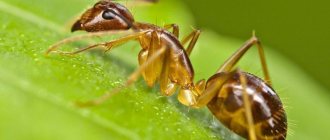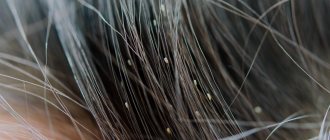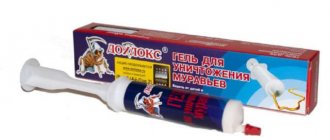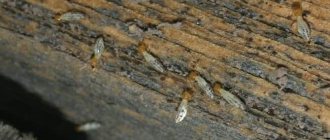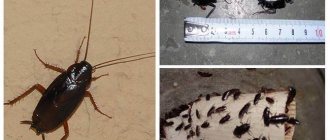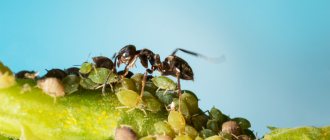People most often become acquainted with this type of insect in person at their dachas, when they encounter ants in a greenhouse or greenhouses. There is no harm from the insects themselves that live in nature, but if the appearance of ants is detected in the greenhouse, you will have to get rid of the aphids bred by them. Once in a home, these beasts, trying to settle comfortably at home, can damage furniture, clothing, and household appliances. Therefore, having noticed even one individual, you must immediately decide how to get rid of black ants in the house.
Studying the enemy
Scientists have discovered a huge number of ant species - more than 8,000. About a thousand more species are expected to be identified in the future. There are several species of dark brown or black ants that harm human households.
Important note: even ants living side by side with people sometimes perform useful functions. They clear the area of dead parts of plants, promote the movement of matter in the soil and kill harmful insects. But at the same time, they can harm living plants or support the population of aphids and scale insects on the leaves. Once in a person's home, some species damage furniture and get into food supplies. Finally, they are simply annoying and can ruin a picnic or even give you a nasty bite. Let's look at these types in more detail. Here they are, all the black ants:
Black garden ants – Lasius niger
A thunderstorm for gardeners, they build their anthills in the grass and feed on rotten fruits; they especially love strawberries. Worker ants are black or dark brown in color and are 3–5 millimeters (⅛–3/16 in) long. Lasius niger queens are extremely durable - the average lifespan is 15 years, and some live up to 30! Anthills are built in the soil and under various objects: stones, wood, remains of building materials, as well as in hollows and inside rotten wood. They feed on small insects and other invertebrates, aphid honeydew and other sweet foods. Aphids are bred on fruit trees and garden plants to obtain honeydew from them. At the beginning of summer, they explore new territories in search of new food sources. They can crawl through brickwork and cement, finding or creating new passages. It is this species that people use for observations, creating artificial ant farms under glass.
Carpenter ants - Camponotus spp
Adult working individuals reach a size of 0.6-1.2 centimeters and are colored black or black with red. If they are disturbed, they begin to emit a specific smell. They feed on insects, aphid honeydew, fruit juice and other sweets. Carpenter ants are truly unpleasant neighbors. They gnaw branched passages and galleries in dry wood where the colony lives. Moreover, from the outside, at first their presence is unnoticeable. We talked more about carpenter ants and how to get rid of them in a separate article.
Odorous house ants – Tapinoma sessile
Small black ants 3 millimeters long. Color ranges from dark brown to shiny black. They have an uneven chest and emit a strong odor if crushed. They feed on insects, aphid honeydew and sweet foods. They lay paths along tree branches, foundations and baseboards in the house, along communications, and along the edges of carpets. On the street they live in colonies in the soil under stones, lying wood or garbage, and in apartments they build nests in the walls of houses, around water pipes and thermal communications. Colonies are usually large, up to 10 thousand ants and with many queens. If there are ants in the walls, entomologists advise spraying insecticides into the cracks. And, if you don’t know exactly where the nest is located, use poisonous bait.
Turf ants
Worker ants are dark brown or black, 2 millimeters long, and all the same size. They feed on sweet foods and insects, and can also get into fatty foods. They do not refuse animal food and prefer to collect food at night. They create anthills in turf, under stones, wood or paving slabs, or create small hills near water sources. There is one queen in the colony. Different colonies are at war with each other.
Crazy Ants
They are yellow and black shiny, 1.5 millimeters long. It is so called for its characteristic erratic and fast movements and the habit of sometimes not following the established route, explain scientists from the University of Florida. They have very long antennae and limbs compared to other species. They hunt insects or collect honeydew from aphids and scale insects. In the United States, the crazy ant is common from Florida to South Carolina and western Texas, but may appear in other states. Also common on other continents, including temperate climates, from New Zealand to Estonia. In some tropical regions they can breed all year round.
Little black ants
Very small ants, from 1-1.5 millimeters. Their presence can be determined by small craters in the ground. They often forage at great distances from the colony, so they are often difficult to control. They live near trees or stone buildings and sometimes climb into the house. They are unpretentious in food. The species is distributed in southern California and the San Francisco Bay area. Species related to it are widespread throughout Southeastern Canada, as well as the Northern and Eastern United States, south to the Pacific Coast.
Differences and features of the species
Black ants are a numerous species; if we talk about their varieties, we can note:
- Garden (ordinary) with a body length of about 4-11 millimeters. You can notice their vital activity with the onset of spring. Garden arthropods are also adapted to life in the city - they can build anthills underground, and they get out through the cracks that form;
- Wood scented insects received this name due to the fact that they emit a specific odor when danger approaches. They live inside rotten trees, rotten stumps, snags, and weeds;
- Woodworms that are listed in the Red Book. The presented species does not cause colossal harm, but serves the role of cleansing and loosening the soil. But for a wooden house, woodworms pose a huge problem, since they gnaw holes in the wood, which is why the log gradually loses its level of strength and crumbles;
- Turf plants penetrate inside a person’s home, spreading through the cracks, thereby populating all the rooms of the building. Therefore, local disposal of such guests is impossible due to the extremely difficult search for nests;
- Crazy people are characterized by chaotic movements indoors. It is worth noting that they bite, and a bite can lead to allergic itching. In addition, an individual of this species chews wires, which leads to damage to devices and appliances.
Most often, the culprit behind the colonization of black ants inside the house is the owner himself, which can be explained by insufficient sanitary conditions.
If you notice uninvited neighbors in your apartment, then to determine their habitat, you should follow just one individual of the family - by watching it, you can easily find out where the entire colony of arthropods has settled.
The best remedies for black ants
In accordance with the recommendations of scientists, we have selected ten remedies for black ant species that can cause trouble in the household.
Spray Levrana
A simple and well-known remedy is a strong, slow-acting stomach poison. Worker ants bring this poisoned food to the anthill and share it with all their relatives, including the queen. The product is used in the fight against insects, including ants. Spray through the entrance to the anthill.
Price: 400 rub.
Sachet Raptor Protection against ants in granules
Non-toxic product. The granules are safe for people and animals - an excellent remedy for black ants in the apartment. Sold in packages. Sprinkle granules in places where ants accumulate and migrate indoors.
Price: 196 rub.
Dohlox trap for killing ants
The remedy for black ants in the house is sold in a pack of six stations. The bait station is installed in the ground or on the surface. Operating principle: transfer poison to a worker ant so that it does the same in the colony. The bait was highly appreciated by buyers. It can be bought in strips or in small stations.
Price: 230 rub.
Raptor Express trap against ants and cockroaches
The gel is squeezed out of the syringe into a place accessible to the ants. It starts working within an hour. The first results will be visible after a few days. This product, containing fipronil, is safe for children, according to the manufacturer.
Price: 259 rub.
Clove oil
Clove oil is not an insecticide, but it is also used to repel insects. The oil is diluted with plenty of water. Warning: Essential oils are dangerous for pets, especially cats, pregnant women and small children. Should not be used in its pure form.
Price: 190 rub.
Damage caused
Despite the fact that insects benefit humans by eating carrion, fallen rotten fruits,
they can cause serious harm to gardening:
- they leave behind aphids, sucking the juice of the young foliage of plants;
- arranging anthills on lawns spoils the aesthetic appearance;
- eat the roots of trees, other green spaces, foliage, sweet vegetables, berries, root crops;
- spread harmful bacteria throughout the garden plot, infecting plants.
Black ants living in houses are also harmful:
- carrying the remains of household waste and technical waste, they bring dangerous bacteria into the apartment;
- damage food products;
- They carry leftover food around the rooms, creating favorable conditions for the development of fungus and mold.
If even one individual of an insect of this species is detected, measures aimed at destruction should be immediately taken.
Comparison table of black ant remedies
| Name | Purpose | Price |
| Spray Levrana | For the treatment of buildings and areas | 400 rub |
| Sasha Raptor | For the treatment of buildings and areas | 196 RUR |
| Dohlox Trap | For home | 230 rub. |
| Trap Raptor Express | For home | 259 RUR |
| Clove oil | For processing areas | 190 rub. |
How to get rid of black ants in the house and apartment: a review of scientifically based methods
The University of California notes the importance of monitoring the current situation.
Ants are attracted to areas near food sources or damp areas. Ants can get into kitchens, bathrooms, offices or bedrooms. Check under sinks, in cabinets, and along pipes and electrical wires. Look for both a large trail of ants and single ants. Scout ants leave the rest in search of food or a place for a colony. If you notice a trail, follow the ants to the point where they enter the building or to the colony if possible. Look indoors and outdoors at foundations and walls for holes or cracks.
In simple words: so that you don’t have to waste energy and money fighting an unwanted neighbor, you should increase your vigilance and not give insects the opportunity to enter the house. “Weak points” must be eliminated: seal cracks, holes and openings in the foundation, walls and window frames, especially around incoming communications. Remnants of food that are attractive to ants, especially sweet foods, garbage and stones, boards and other flat objects lying in undesirable places on the ground are also removed. Wash the areas where black ants have appeared in the house with a soapy solution to remove the smell that the insects use to navigate.
The University of Kentucky also notes the importance of cleaning and maintaining cleanliness, but also clarifies that the use of chemical insecticides in controlling visible ants is not effective.
The mistake most people make is to immediately spray insecticide on visible ants. This approach usually fails because the visible insects are only a small part of the colony. Typically, there are thousands of ants inside, including one or more queens.
Killing queens and other insects within the colony is key to effectively controlling their numbers.
Entomologists from Texas A&M University offer advice on how to remove black ants from your home. Colonies inside walls can be controlled by injecting an aerosol through cracks and crevices around baseboards. If the exact location of the colony is not known, poison baits can be effective when placed near trails.
You can achieve your goal and kill the queen only by delivering poisoned food to her. There are a large number of different baits on the market, the poison of which acts slowly like a domino effect. The poisoned ant manages to distribute food to its relatives or the queen before dying. It not only brings food to the colony, but also attracts other workers to the bait. When used correctly, baits and bait stations are much safer than sprays. They are especially effective in early spring.
For indoor use, manufacturers produce baits in solid or liquid form, packaged in stations or in tubes. Sometimes baits are mixed with boric acid into one liquid, poured into special reusable containers, or drops are left in places convenient for ants and inaccessible to people and pets. The University of California believes that baits in dispensers or reusable stations are more effective than those packaged in disposable traps, especially for liquid baits that dry out quickly.
Gel dispensers are used when you need to leave a small amount of bait in hard-to-reach places: in cracks, behind baseboards or on utility lines.
Different substances in baits affect different types of ants and at different times of the year. Sweet baits are suitable for carpenter ants and odorous house ants turf ants are completely omnivorous.
Poisonous ingredients also vary from manufacturer to manufacturer. It is not recommended to use granular baits with cyfluthrin, permethrin, propoxur and indoxacarb due to the too rapid action of the active substance. In the top 10 below we have listed the active substances used in baits.
Finally, you should not use baits in a living space unless absolutely necessary, as they can, on the contrary, attract ants into the house for a while. The result will not be noticeable immediately, but after a few weeks.
Where do insects come from?
Black ants settle on the street, but their appearance in a house or apartment is not considered a big surprise. Why did they move to man, and why did they stay? Common reasons include:
- it’s cold outside, but the house has all the conditions for living;
- moved from neighbors who began to fight them;
- There are often pieces of something sweet or simply edible left in the kitchen, which attract ants;
- your apartment or private house is an ideal place for ants to live, it has a source of water and a lot of food;
- The anthill is located near your house.
How to get rid of black ants in the country house and garden
These methods are similar to those described above.
On a personal plot, as in a house, you first need to do a thorough cleaning: remove leftover food from pets and livestock, remove old grass and fallen leaves from the area, sort out haphazardly stored things, tools, building materials, etc.
After this, you need to find all the habitats of black garden ants and treat them with chemical or natural means. It must be remembered that a large anthill or large ant habitat requires more thorough treatment with a larger amount of insecticides. Sometimes re-processing may be necessary, because... the product may not get into all ant crevices and passages and not all insects will die. The most important thing, as has already been written about above, is to destroy the uterus. Then the colony will not recover.
In the garden, the use of baits without a long-lasting sticky layer is very effective. They act slowly but surely, and in the vast majority of cases they kill the queen.
After you have removed the ants from your local area, you need to take measures to protect it; without them, the ants will soon settle in again.
- Maintain order throughout your area, do not leave leftover food and rotten grass and leaves.
- Do not plant flowers, bushes, or trees whose flowers produce a lot of nectar, which is so attractive to ants.
- To protect your garden and garden, use baits that will divert the attention of insects from your territory.
The main reasons for the appearance
These black individuals can enter the home through pets. They bring them in on their fur from the street, after visiting an infected attic, basement and other places. Garden ants, immediately after fertilization of the female, begin to create new colonies of their own kind in the bark of trees and soil.
Thus, populating garden/vegetable plots. With the onset of cold weather, ants rush to occupy warm places in a person’s home.
Other reasons include:
- As autumn approaches, black ants begin to literally populate basements, attics, and garbage chutes. As soon as their number increases, they spread through ventilation systems to all neighboring apartments. Ants can climb through small cracks, holes, gaps in window and door openings, walls, and baseboards.
- Often, it is the owners themselves who are to blame for the presence of ants in their home. Crumbs, spilled tea, the smell of stale garbage - all this attracts them. It is worth starting to observe sanitation throughout the house, apartment, and even in the local area.
During the heating season, a furnished attic, a heated basement, warm houses and apartments help ants survive by arranging nests in them. Cold has no effect on the reproduction of black ants. Therefore, the problem needs to be resolved immediately.
How to Get Rid of Black Ants Using Natural Remedies
Diatomaceous earth is used to physically control ants and other household pests. The mineral substance, the remains of diatoms, is ground into flour, making the substance sharp enough to cause fatal damage to insects by cutting through the chitinous covering. Diatomaceous earth is safe for humans and pets when in contact with elastic skin.
Some baits or separately use boric acid, which can be purchased in powder form. It is effective against a colony of carpenter ants in a home wall or inside furniture, where boric acid spreads through the hole and is distributed along the passages and galleries of the anthill.
Clemson University lists limonene among herbal remedies effective against ants.
Limonene is derived from citrus oils extracted from oranges and other citrus fruits. It is used as a contact insecticide against ants, cockroaches, bedbugs, fleas, silverfish and many other insects. Limonene has low oral and dermal toxicity to mammals, birds and fish, although it may cause irritation in some people. Limonene is the active ingredient in Ortho Home Defense Indoor Insect Killer. But safer are Fire Ant Killer and Citrex Fire Ant Killer, which also contain this ingredient.
Widely used in the manufacture of insecticides with natural ingredients eugenol, the active component of clove oil. It is used in the fight against ants, cockroaches, ticks, flies, wasps, spiders and other arthropods, including herbivorous pests. Eugenol has a rapid effect on the insect, but is not considered hazardous to the environment. But it irritates the skin and mucous membrane of the human eyes, so it is recommended to wear glasses and rubber gloves when using it. Often used in combination with thyme, sesame, rosemary and other oils.
General information about black ants
Black ants are a species of arthropods that live in all corners of the planet, except Antarctica, Greenland, and some islands in the world's oceans. Insects have taken root in the desert, forest, steppe, and even in the permafrost zone. Representatives of black ants live in Great Britain, Portugal, central Russia and the Far East to Ulaanbaatar.
They are so named because of the color of the body, legs and head - from brown to black. They are characterized by an impressive head on a thin short neck, a sternum narrowed towards the rear and an ovoid belly. On the head there are two jaws and two pairs of short mouth appendages. The eyes of ants are large, consist of lenses and are shaped like a honeycomb. They also have three pairs of paws with claws, two pairs of thin wings and curved antennae on their heads. Insects can range in size from 1 mm to 3 cm, with females being the largest among their relatives.
The ant's head contains large eyes, powerful jaws, two pairs of short mouth appendages and long antennae.
They mainly live in built nests, which are easy to find by their characteristic mound. An anthill is a rigidly structured community. Each family member is assigned a specific task. Some feed the growing tribe and the queen, others find food and repair the house. The lifespan of black ants is determined genetically and is determined by their belonging to a separate class: workers, queens and males. Caste is determined at the moment of birth and does not change during life. Entomologists have found out the duration of the life cycle in the caste:
- Working ants - from one year to three years. Large representatives live longer than small ones, and the lifespan of individuals in cold climates is shorter than in warm climates.
- The life of a male insect lasts 2–3 weeks. They are born to mate, after which their brothers destroy them. When there is more than one queen in the anthill, the producer is left alive.
- The queen lives up to 28 years, which is 10–15 times longer than a worker ant. During this period, she produces 500 thousand offspring.
They eat any protein foods and plant products. Some representatives choose seeds, nuts, tree sap, plant roots, and sweets. Others breed colonies of mushrooms, which they eat along with insects and caterpillars. The queen and larvae feed on protein foods: the remains of insects and other living creatures, and eggs of pests. The larvae of black ants living in a human house make do with dairy products, gelatin and egg waste.
